A new project from the IBM Labs – IBM Connections Touchpoint…
The IBM Connections Touchpoint provides an interactive user experience that can be used for a wide variety of end user touchpoint scenarios, such as new user profile creation, community and network contact recommendations, organization polling and more, driving user engagement and increasing the business value of your organization’s social business platform.
Perhaps the best way to describe this is via screenshots:
Here’s the starting point:
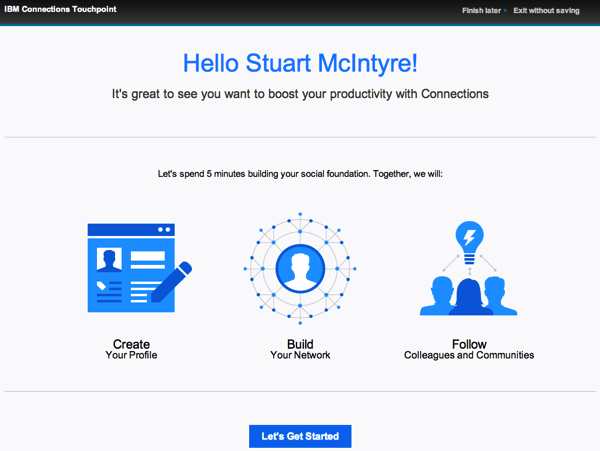
The ‘Let’s Get Started’ button leads to creating your profile:
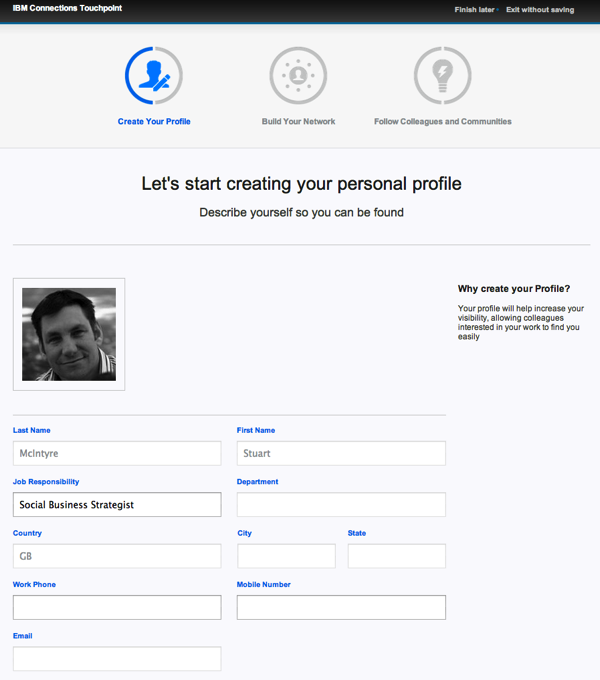
Add some tags/interests:
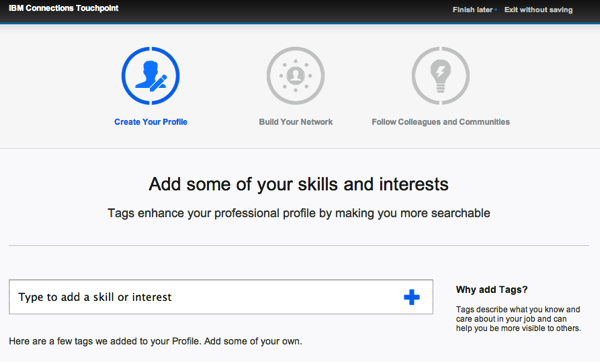
Add some network contacts, including some suggestions from the platform:
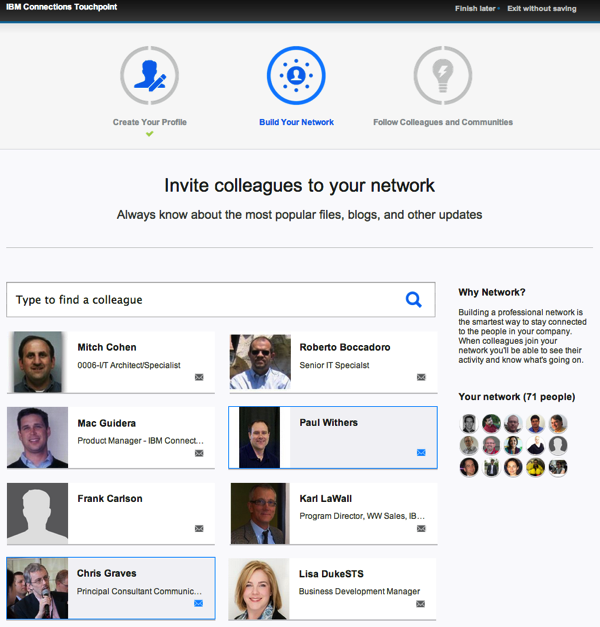
Then some key colleagues to follow:
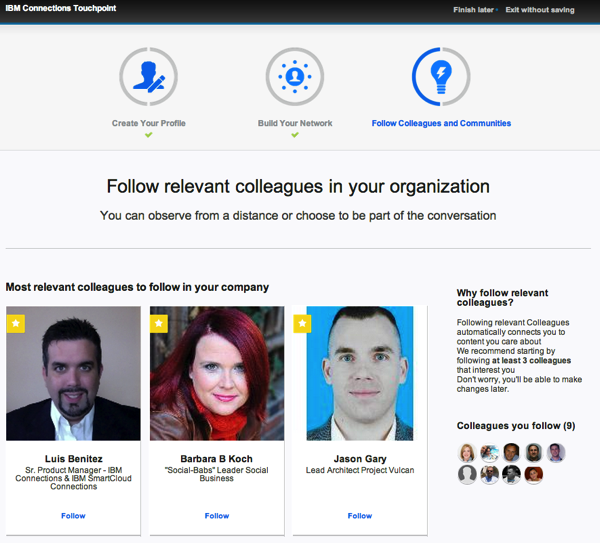
I particularly like the hover functionality on this page, showing recent content:
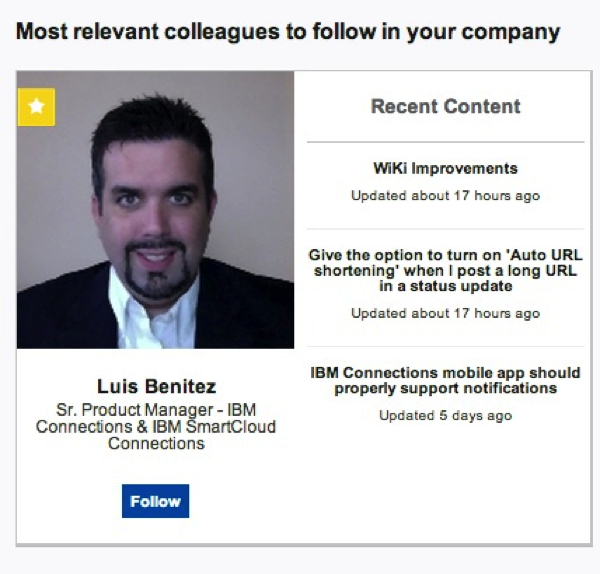
And finally, some communities:
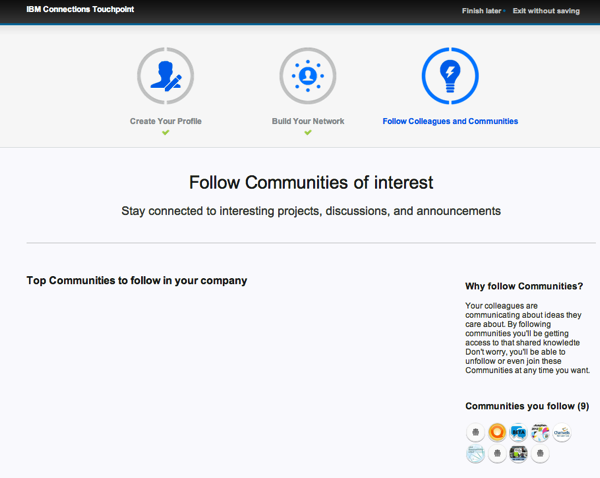
(Unfortunately on the Greenhouse this isn’t populating right now.)
Then your data is processed and you are redirected to the Connections Homepage Getting Started tab as usual.
I think this is a fantastic idea, and is much needed in the product. It would be a tremendous link to send to newly added users or to be included in an on-boarding pack handed to new starters. I also believe that this more friendly UI style is something that could be carried into other areas of the product.
Great work, IBM… Hoping Touchpoint makes it into Connections Next!
Try Touchpoint yourself now (Greenhouse ID needed), and let me know what you think in the comments below!

While I understand the following concept I definitely do not get the network concept in Connections. Actually a good topic to write about.. hold please
I look forward to your post on that, Chris. You do have a point. However, I always think of it as a means to inform others on those you work most closely with. Say a user is trying to contact a colleague urgently, but they are on vacation. Who would you go to next? One option is to look at the Reports-To chain (i.e. contact their manager or one of their peers) – however in many orgs that is not really indicative of working relationships, more a representation of organisational hierarchy. The other option would be to look at the user’s network – who in their group of (say 5-10) network peers has a job title or responsibilities most closely aligned to the knowledge required?
Update: Touchpoint is currently an ISSC Asset, which means that it is procured, implemented and customised as part of a services engagement with IBM.
Thanks for posting about this Stuart. A few comments here – http://michaelsampson.net/2013/12/09/easy-first-steps/ – and some context in terms of how this fits into my User Adoption Strategies work.
Thanks Michael, completely agree. This is just a help in getting users started – there’s much more to be done once they have populated their Profiles and populated their networks.
I’m on the ISSC Social Business Applications team that created Touchpoint. We think that it is a great way to get users started with Connections (of course), but also believe there are other compelling uses for Touchpoint such as annual reminders to update profile information, ensuring users complete mandatory education sessions and introducing new functionality after an upgrade. That’s why we named it Touchpoint as it can be applied to a number of user engagement scenarios. Because it is an ISSC App we can customize it as needed as part of a services engagement. We’d love to hear other use case suggestions.
Thanks Cynthia, I really appreciate you taking the time to add this info.
Is it possible to give customers and partners a rough guide to the cost of Touchpoint assuming limited customisation is required?
As Cynthia mentions in her comment, IBM implements Touchpoint as part of a services engagement, where we can tailor the process to the specific customer need. So pricing will definitely differ based on each situation, but we’ve been seeing this component included at around $32,000 in the US. That includes a licensing fee that entitles the customer to the full IBM Technical Support for the solution, similar to Connections product support (same #, same web submission) and the services fee to deploying into the customer environment. If there are customization requirements, additional services fees may apply.